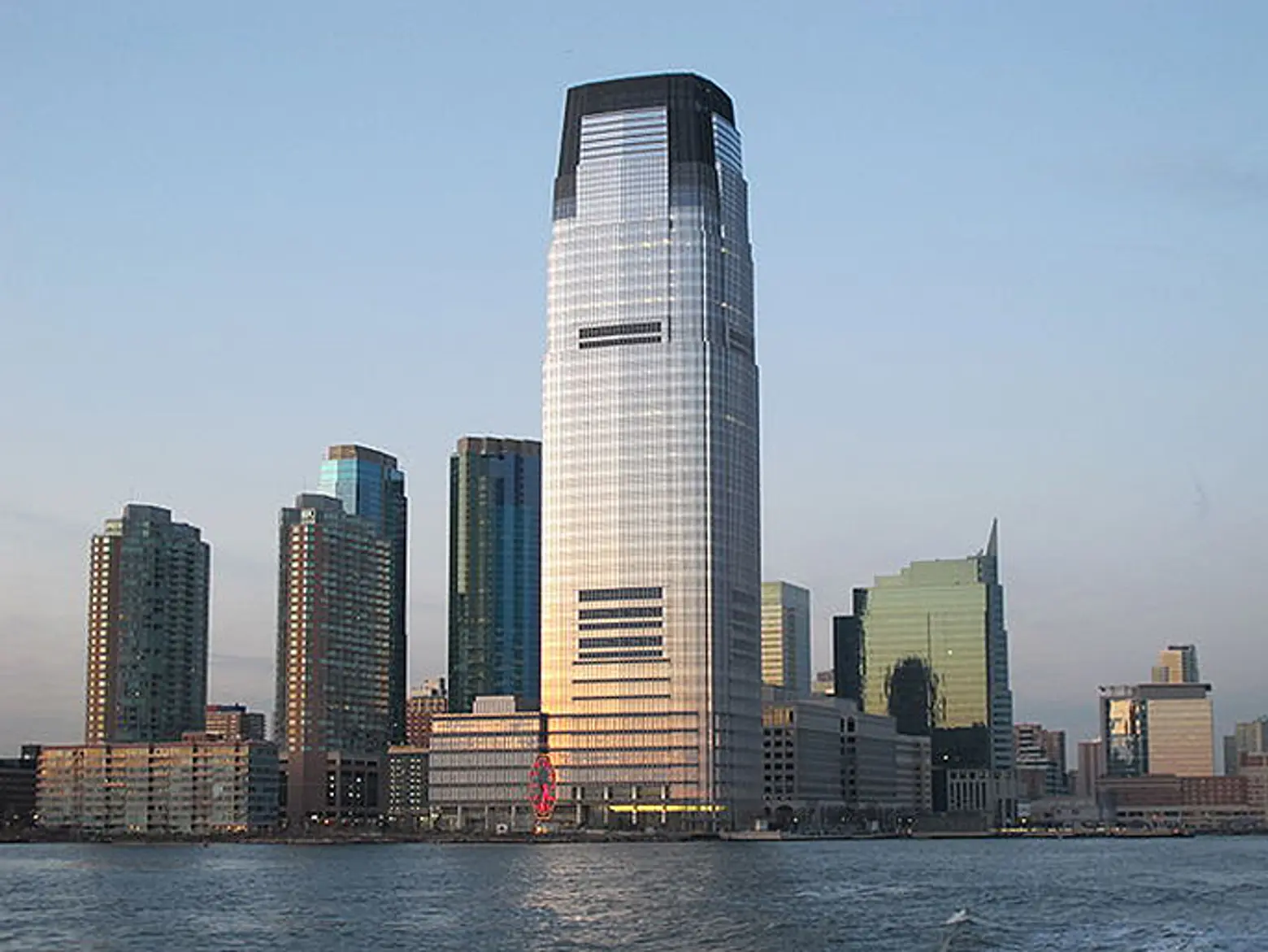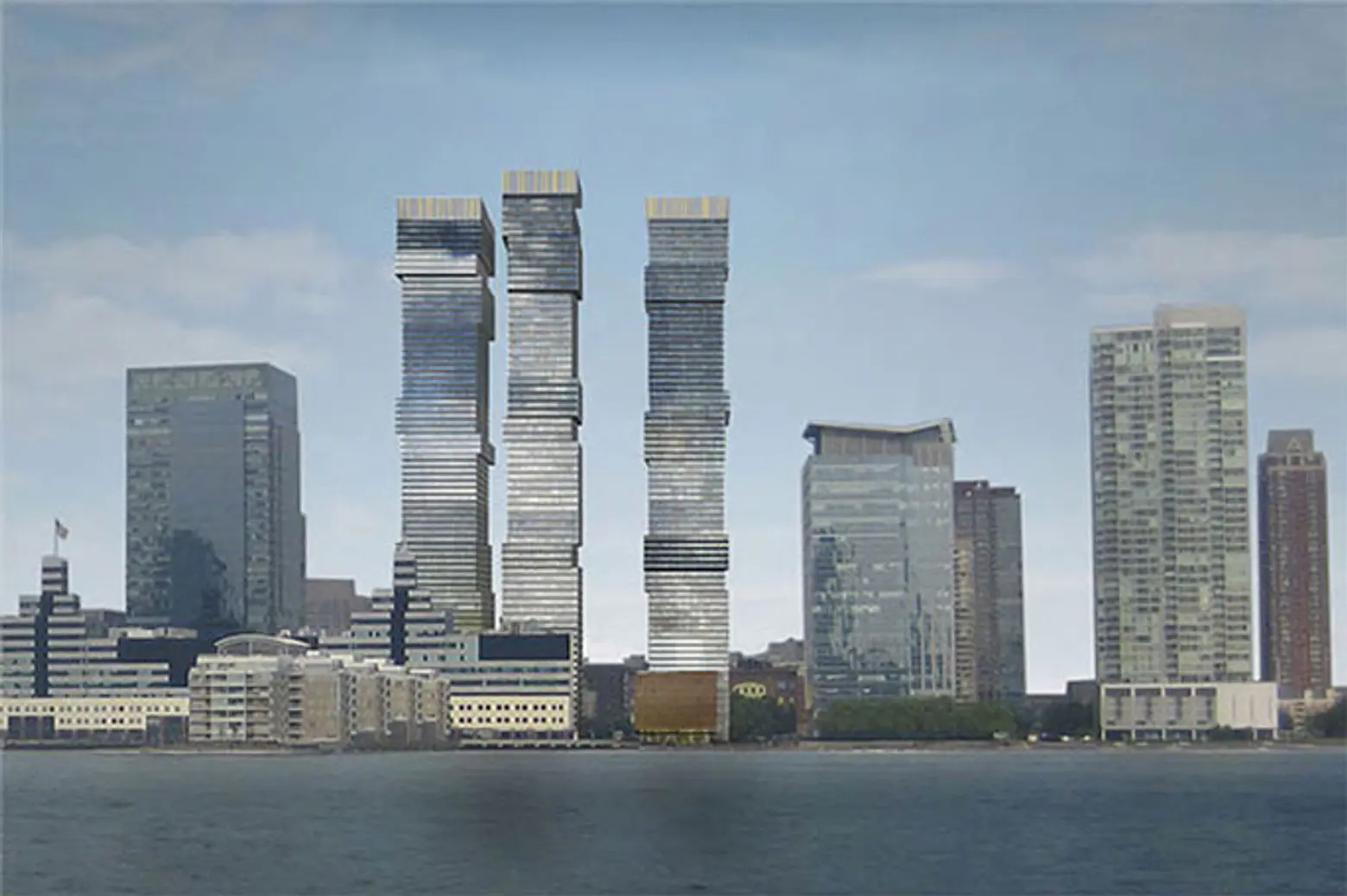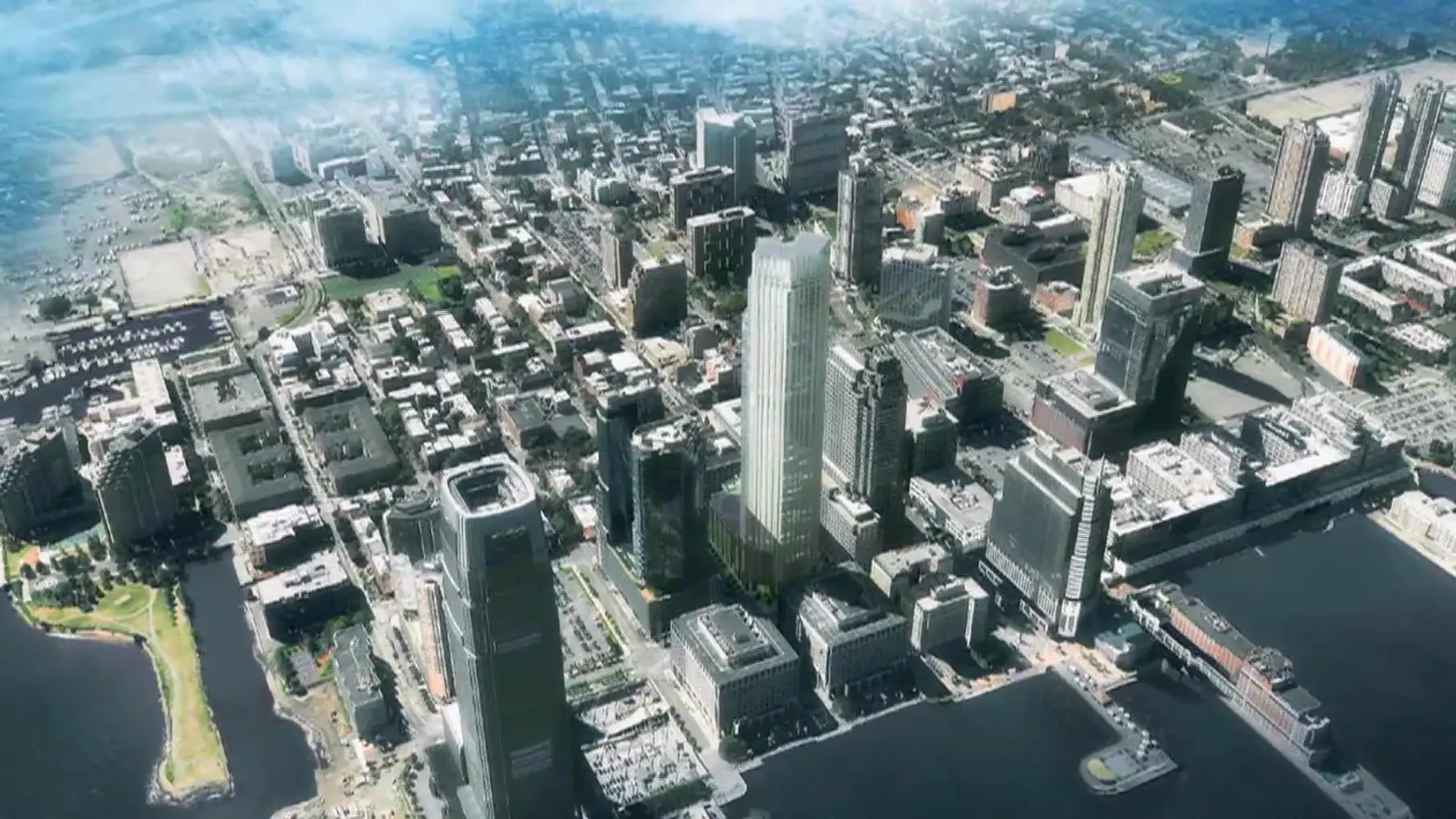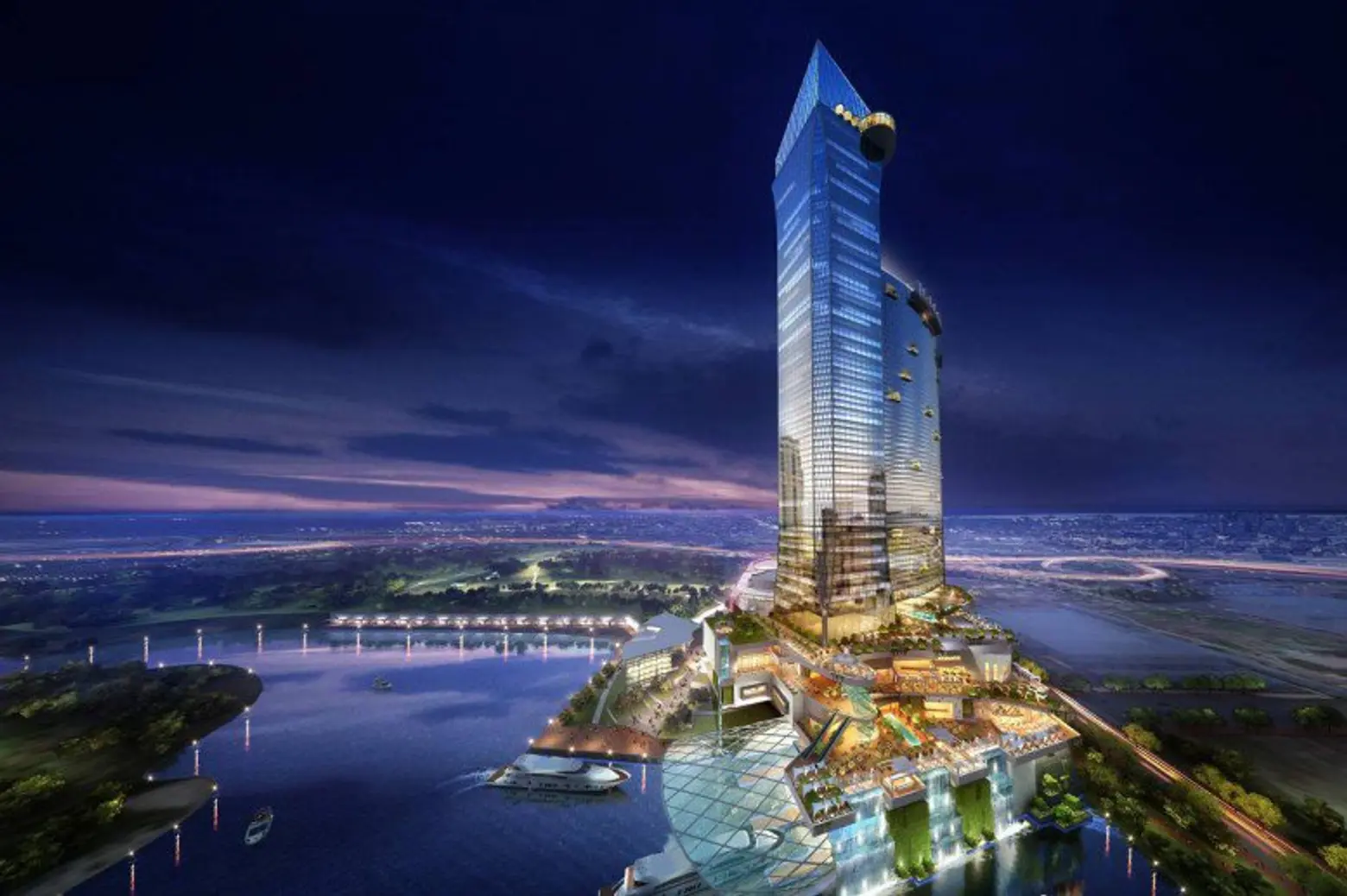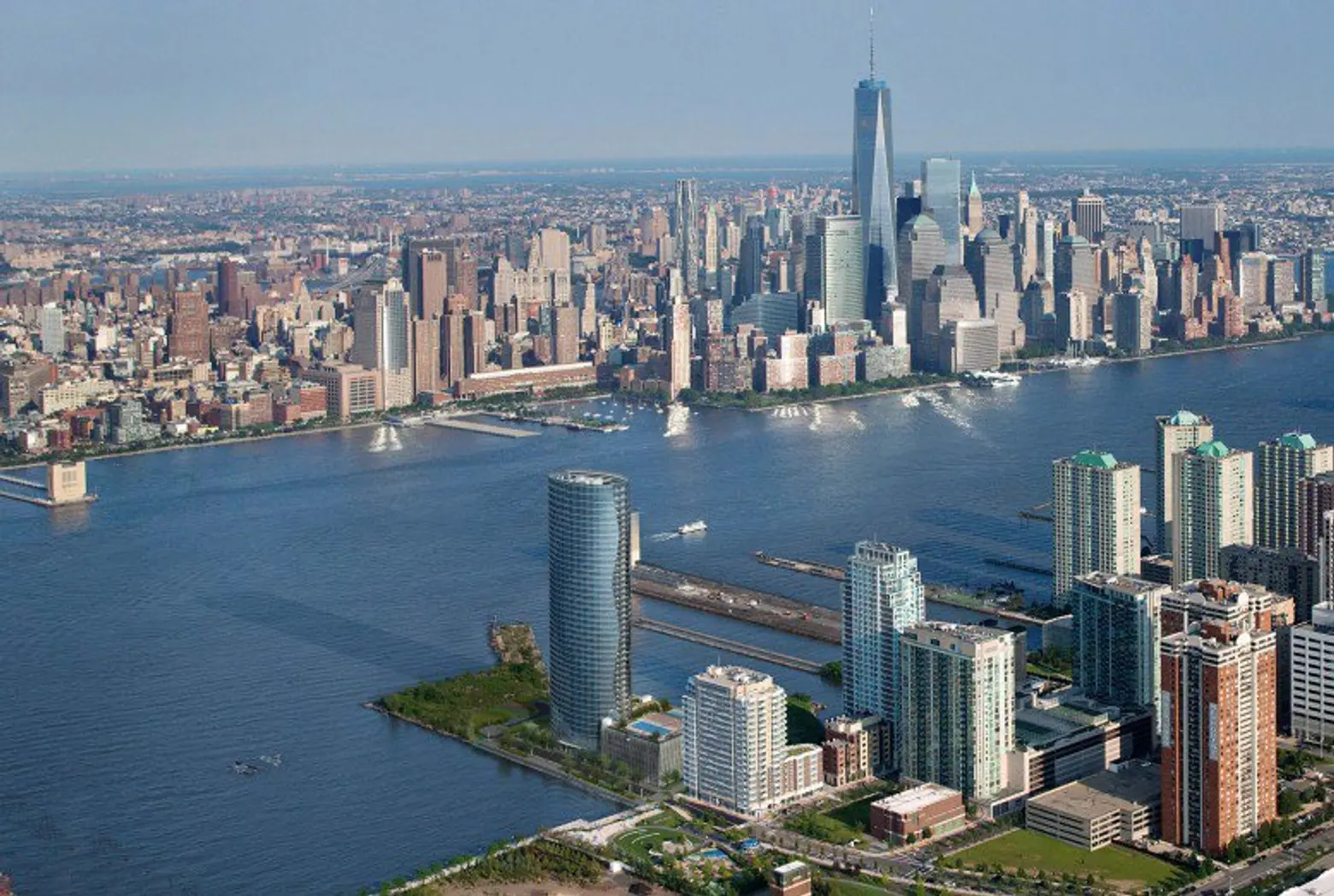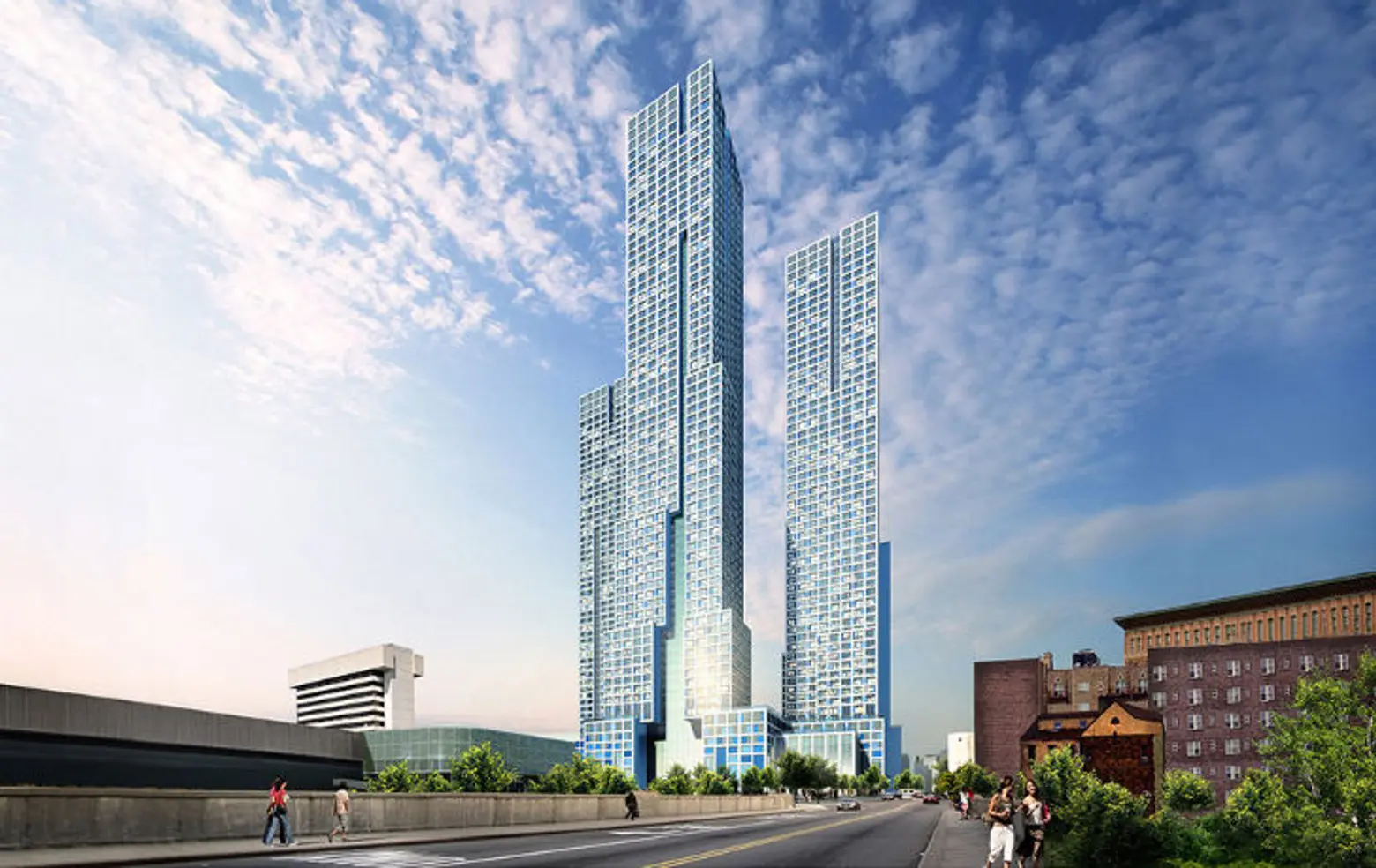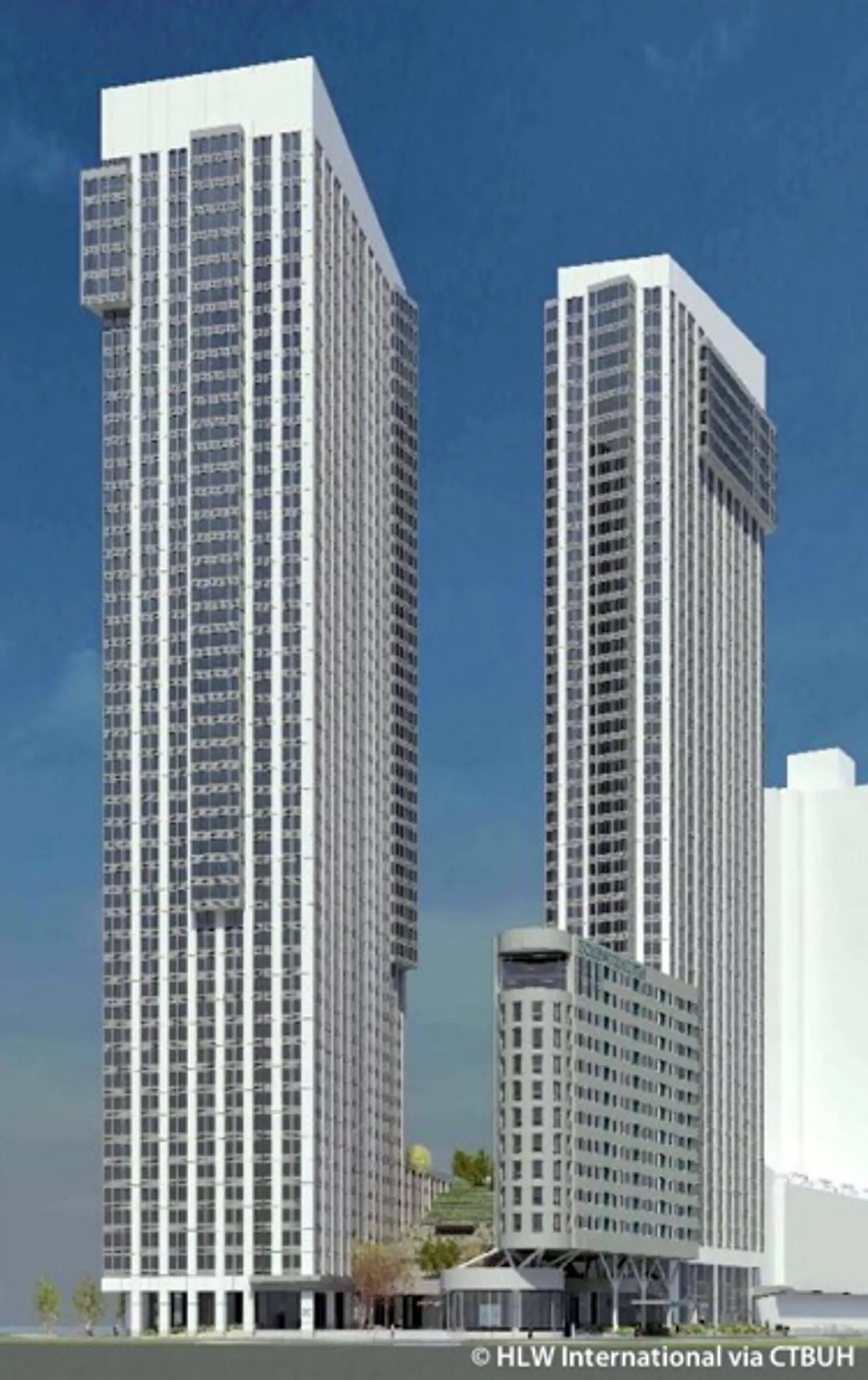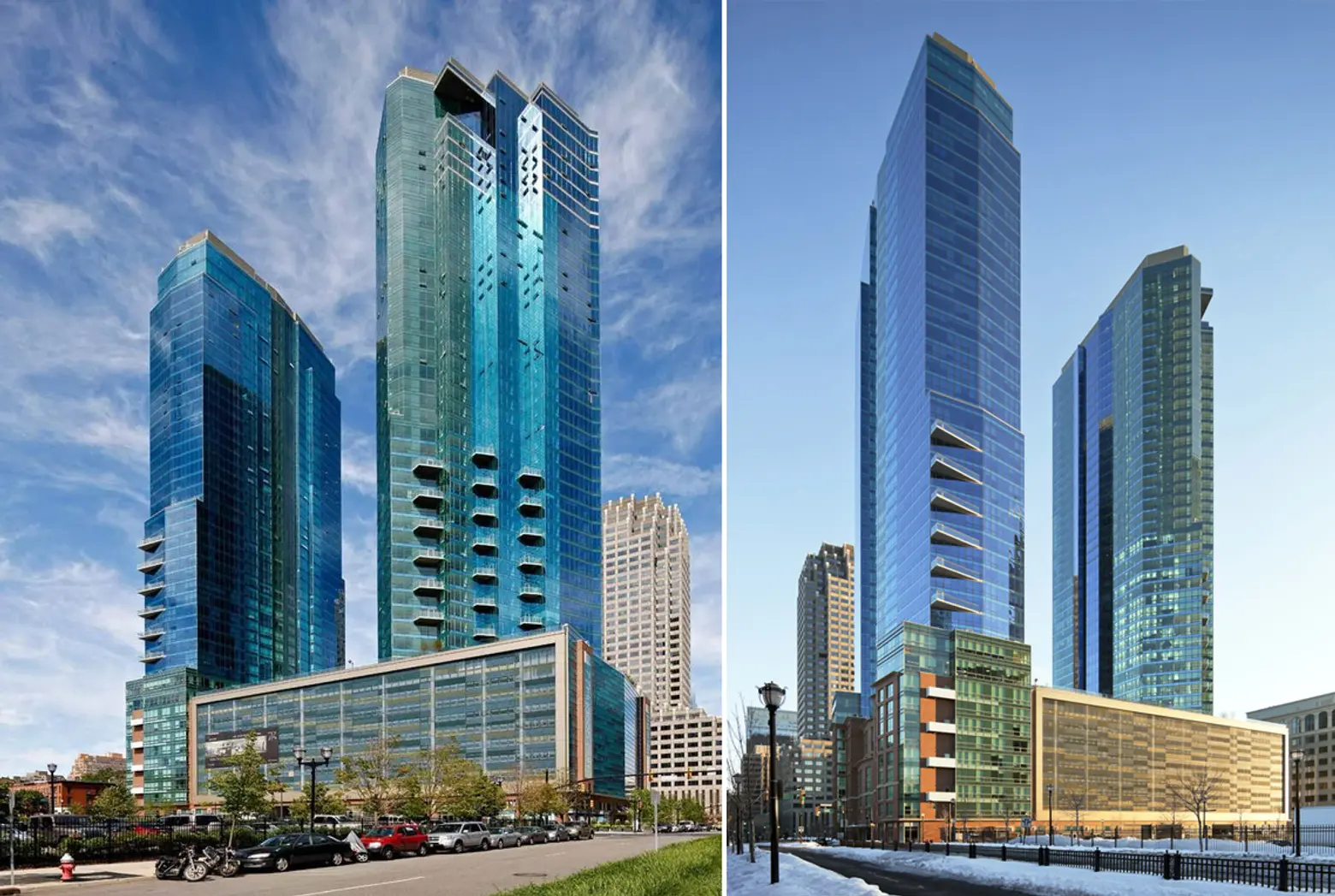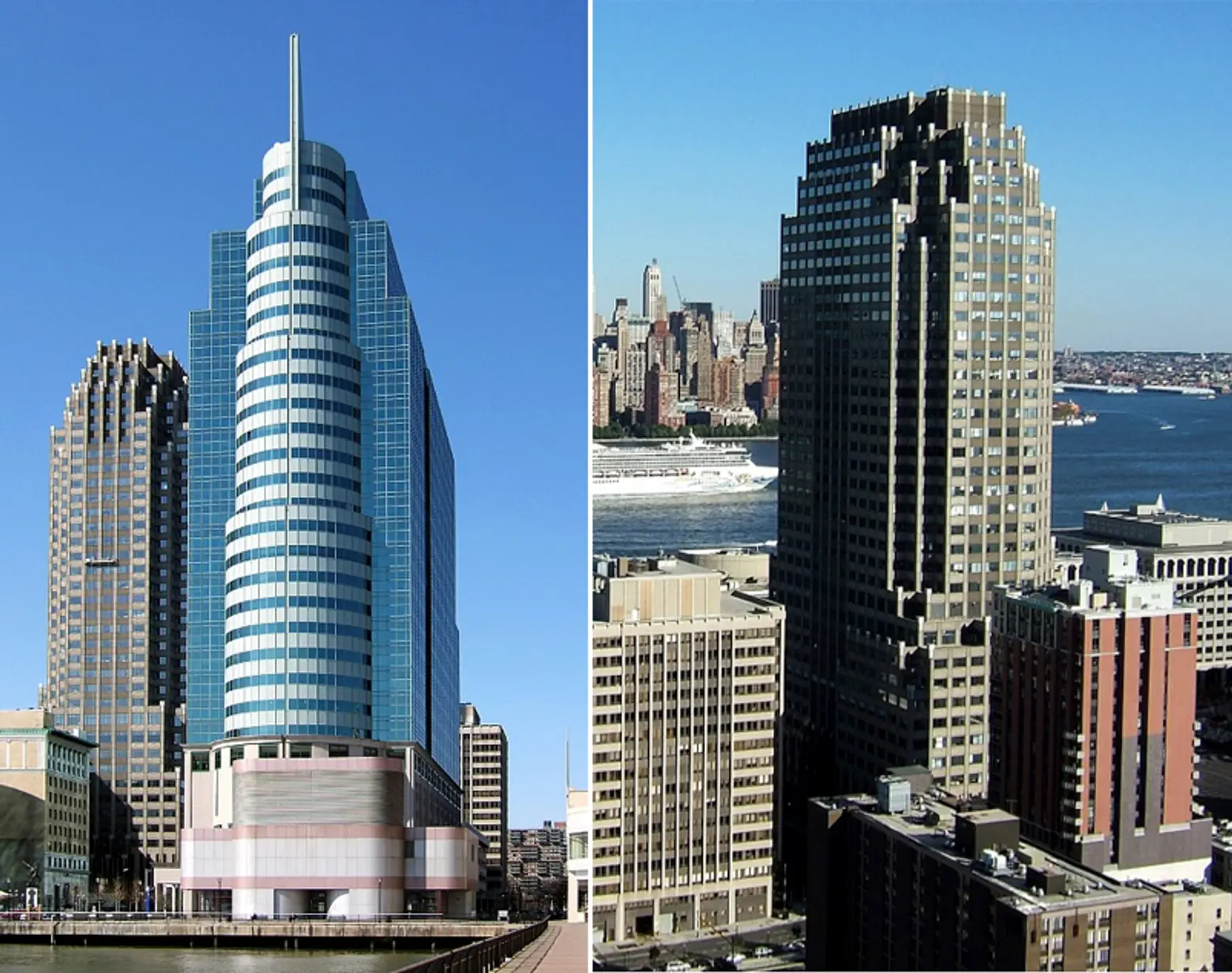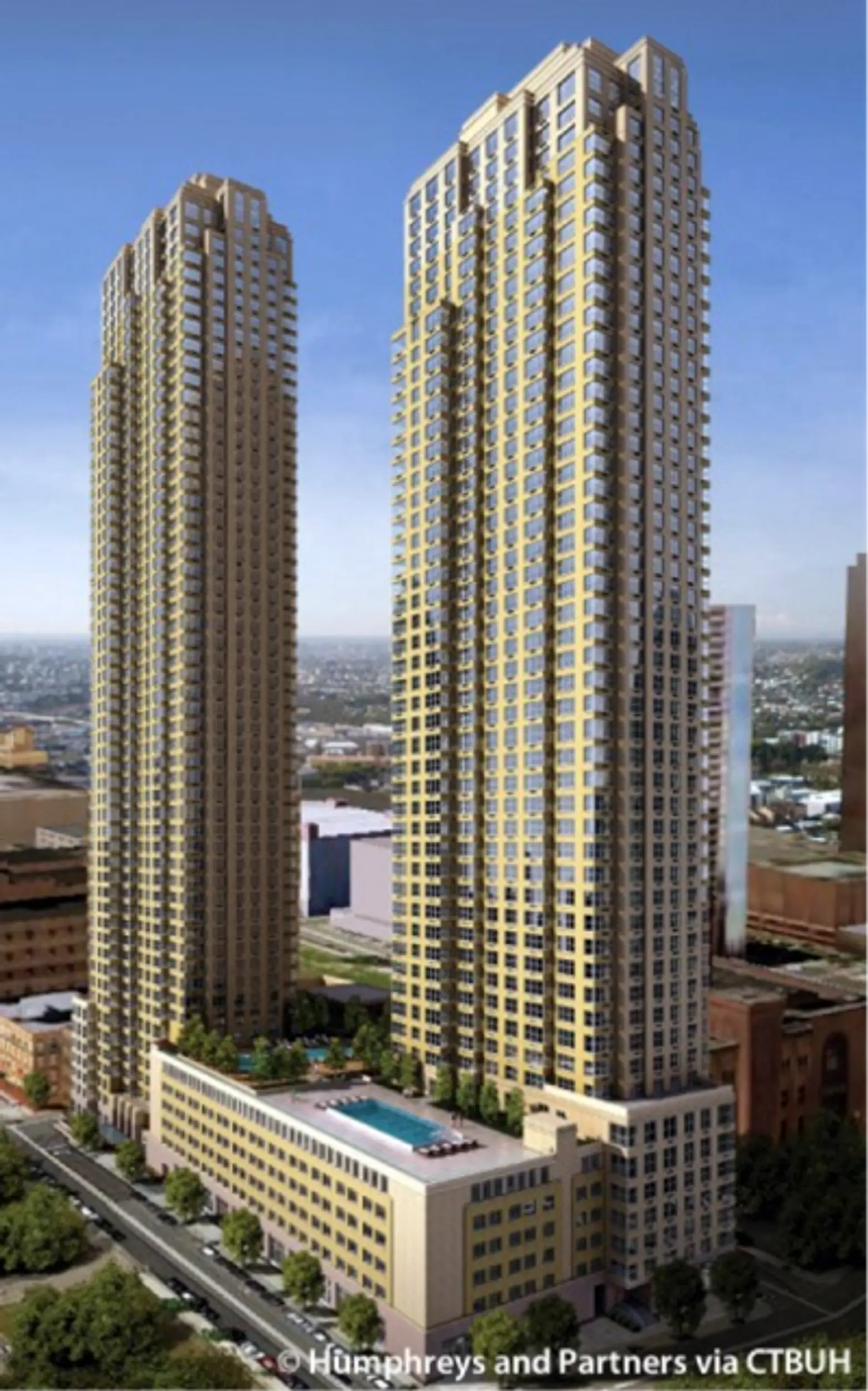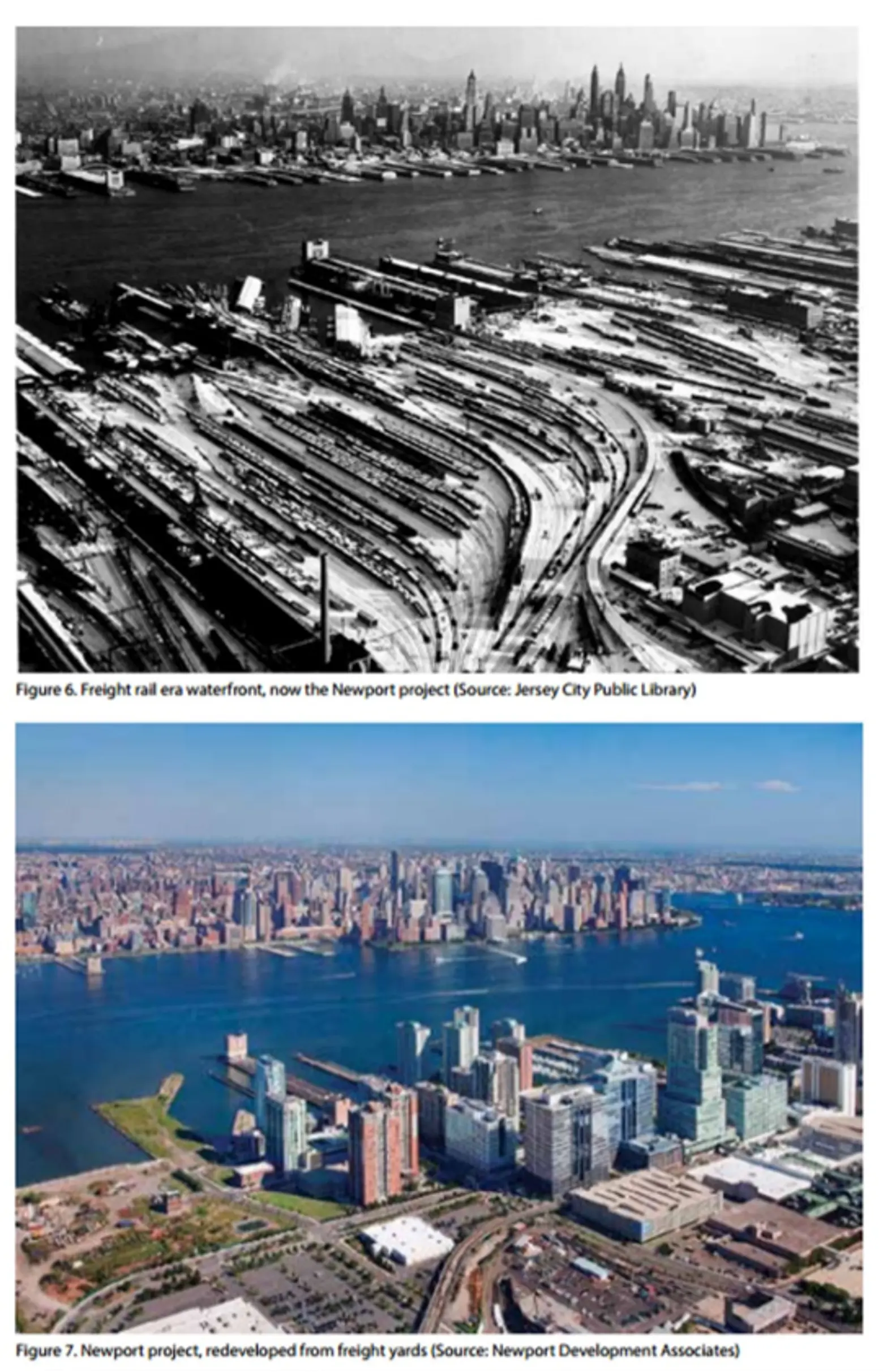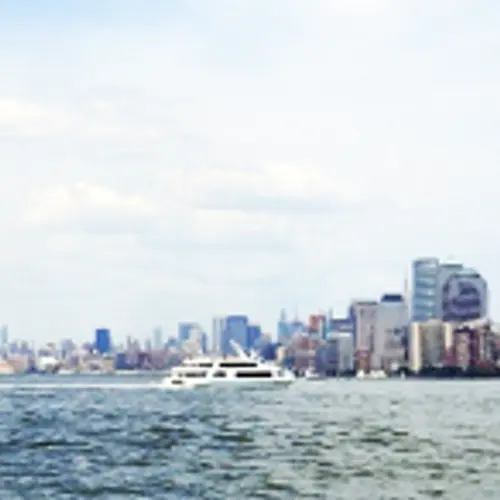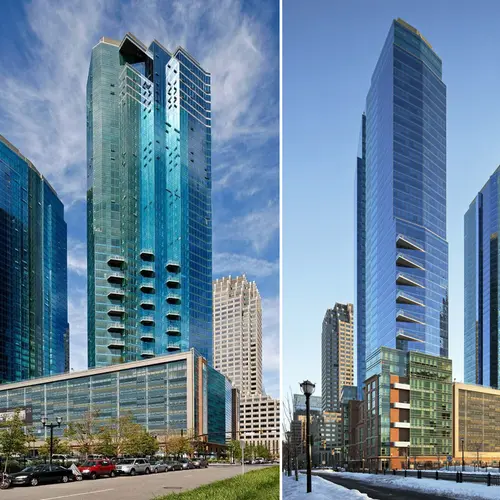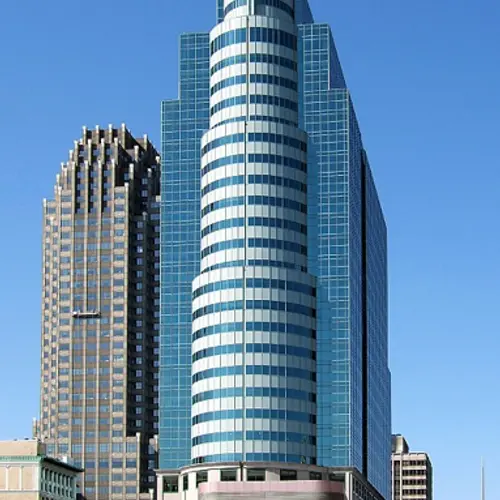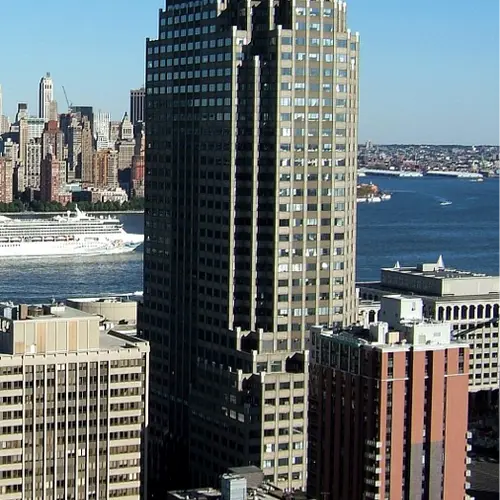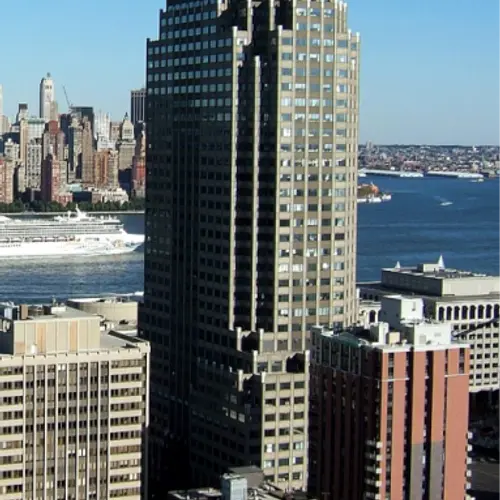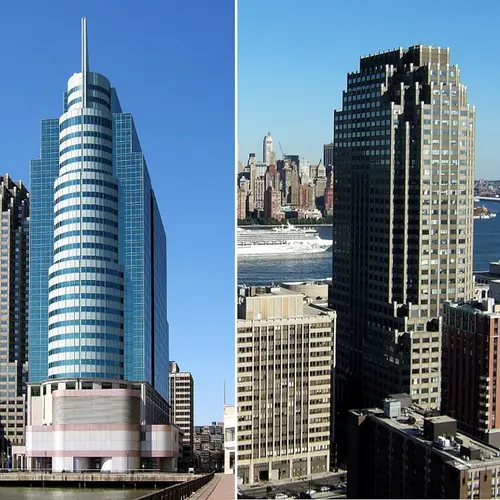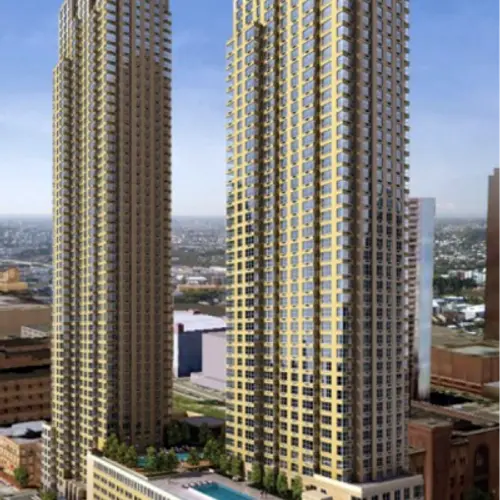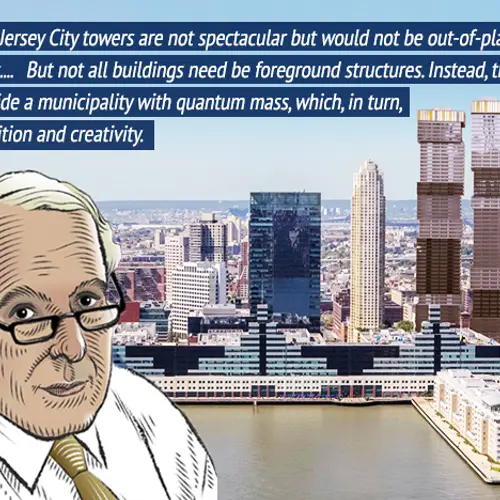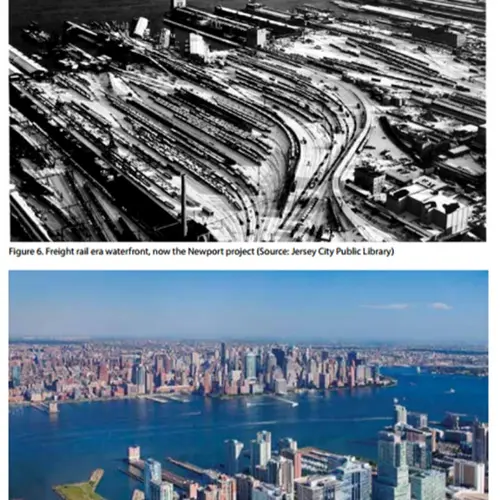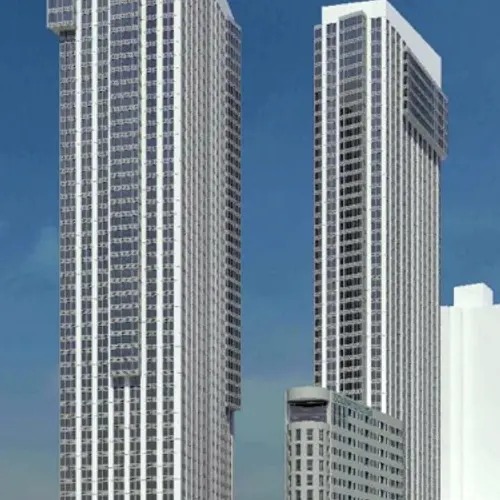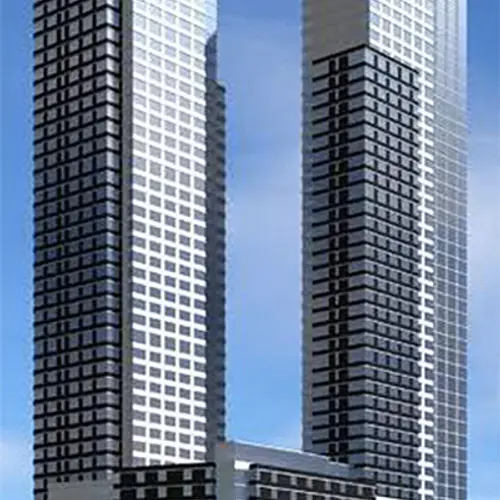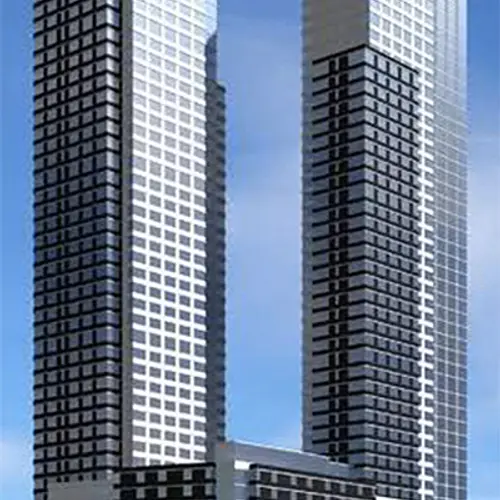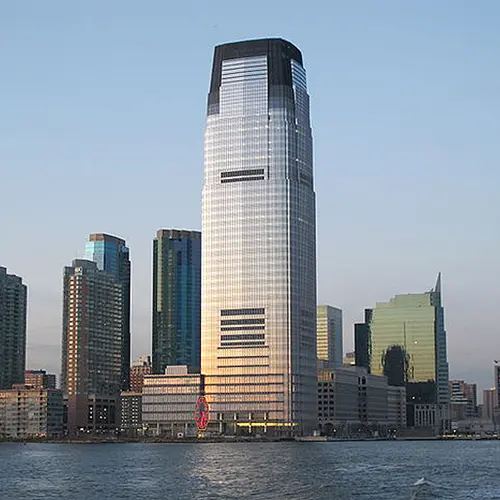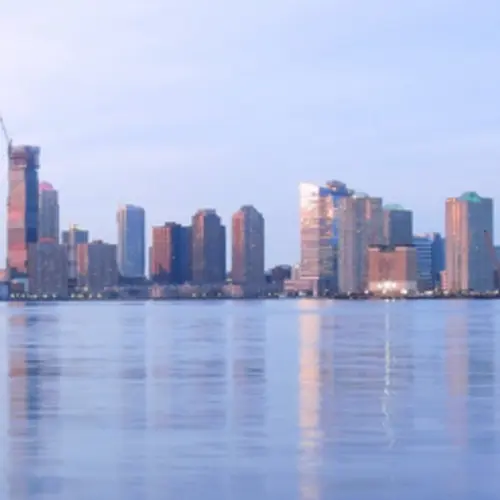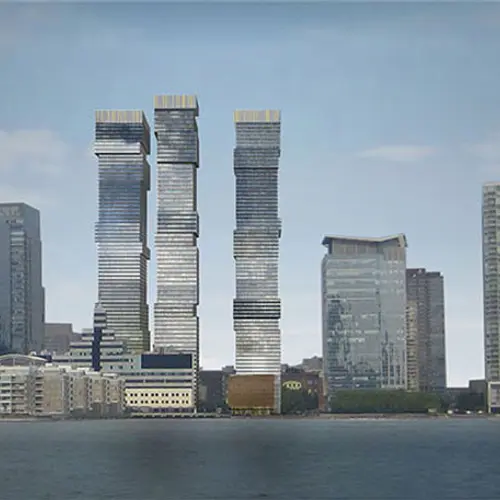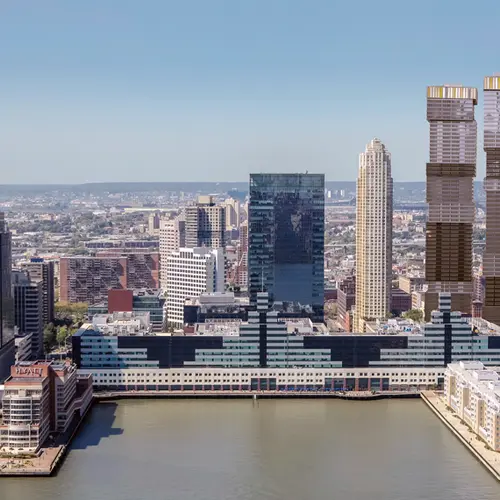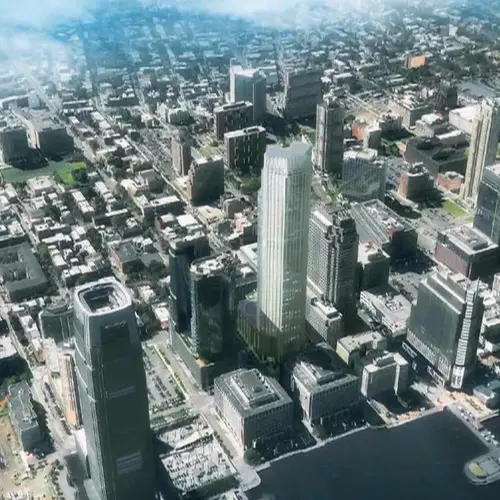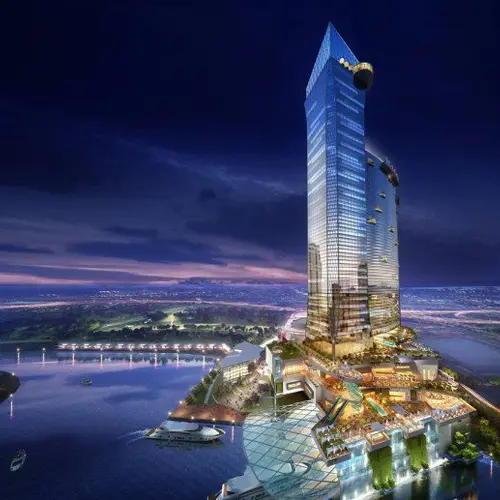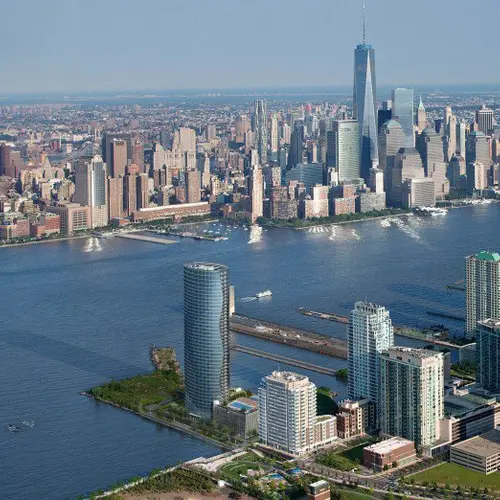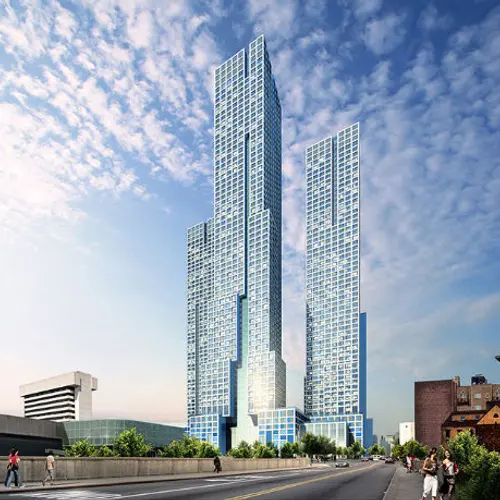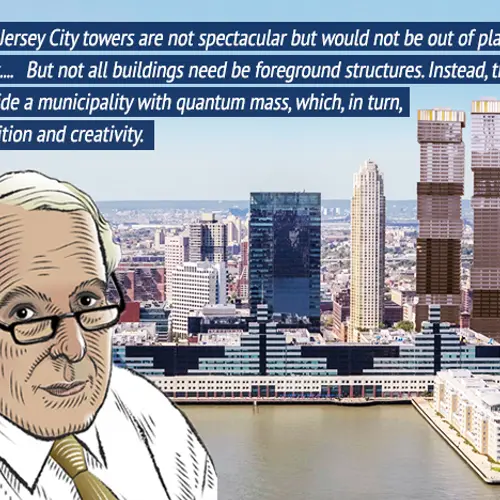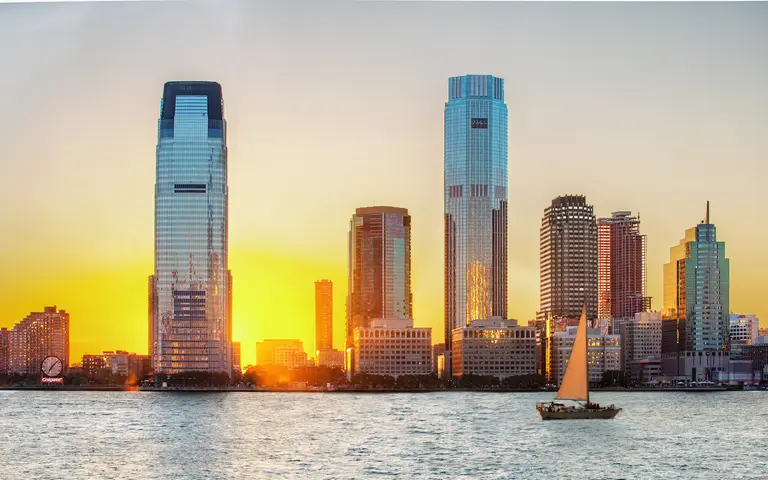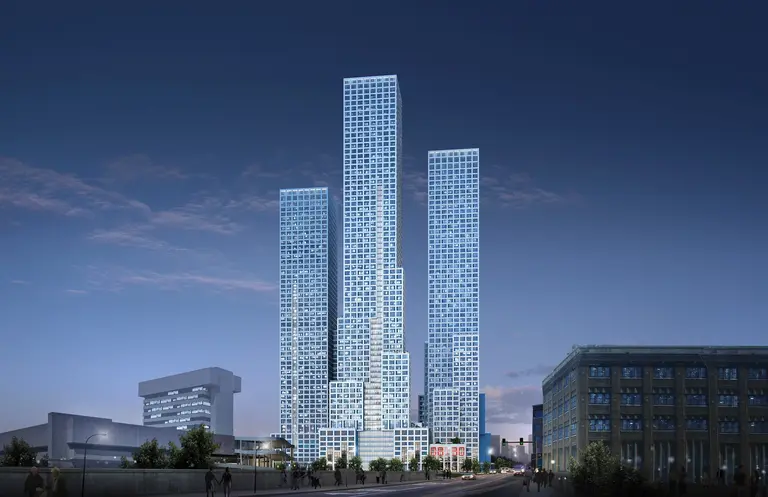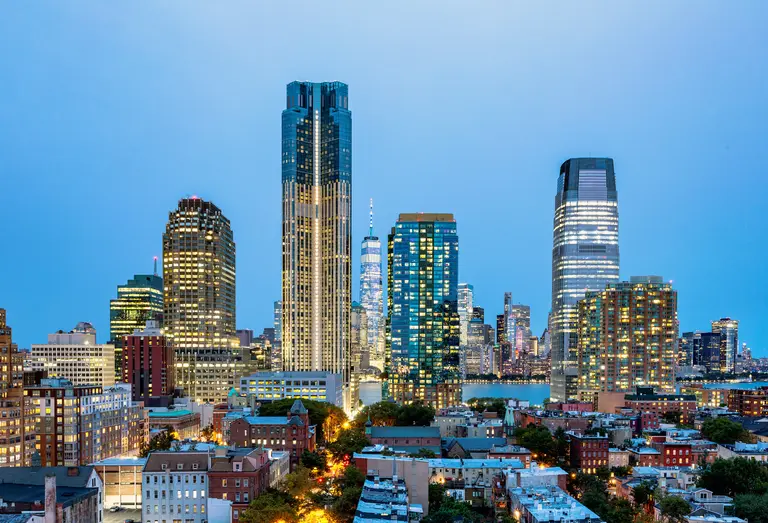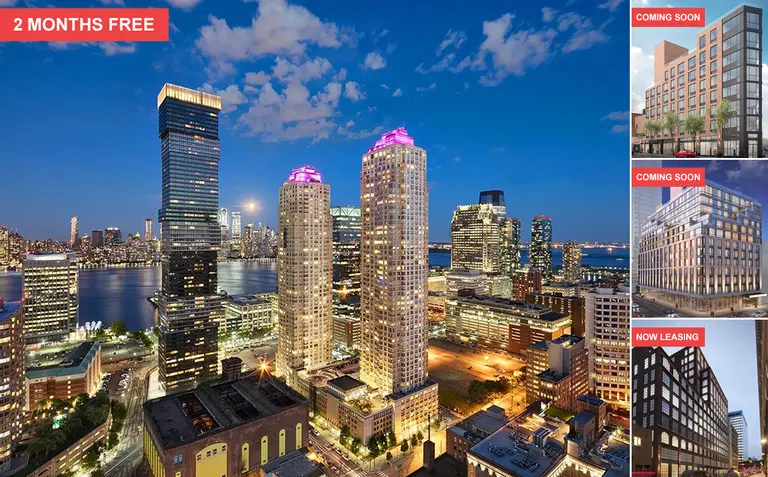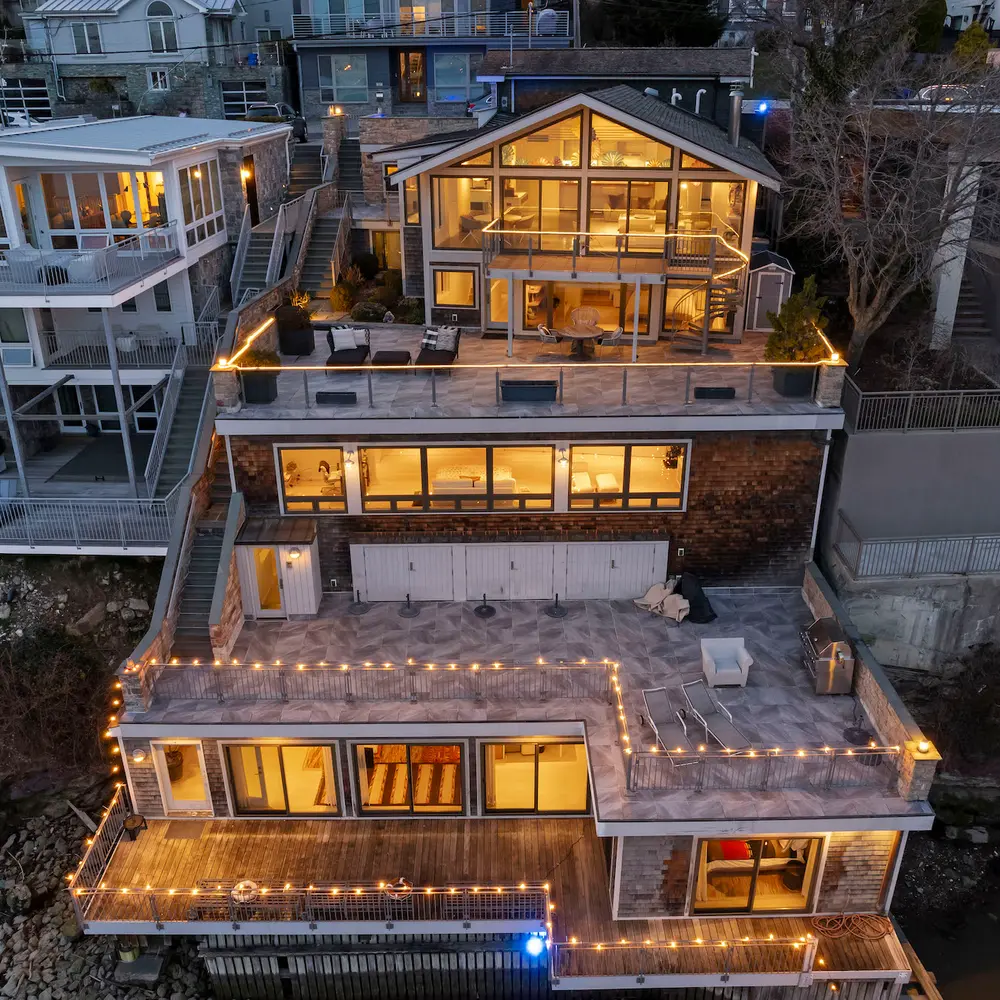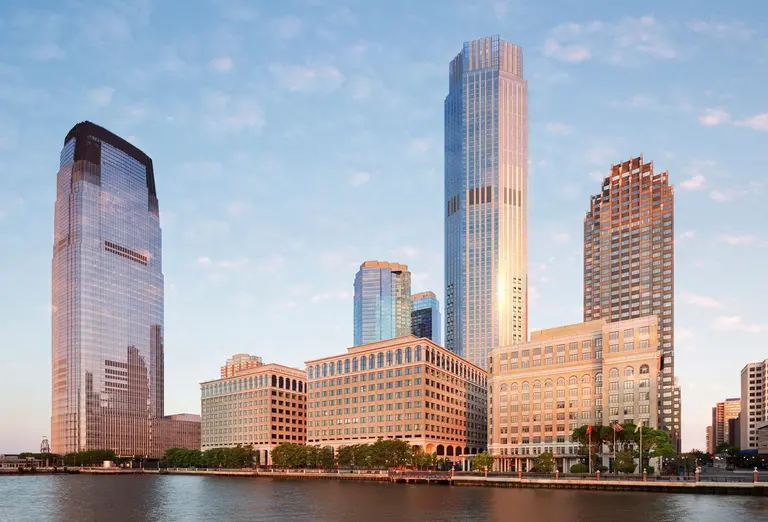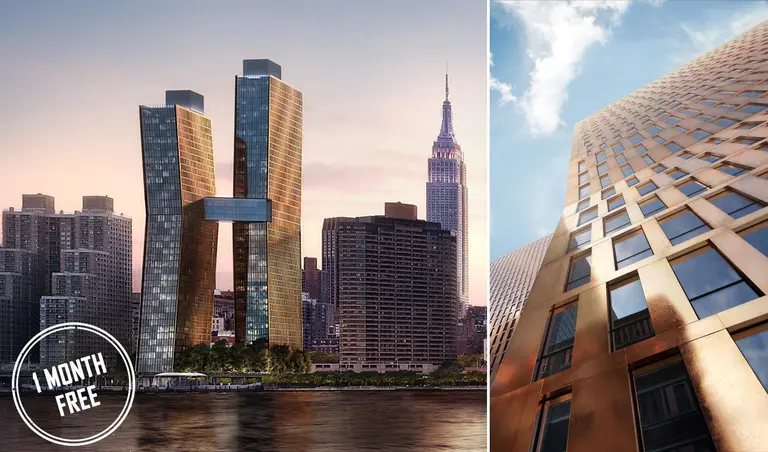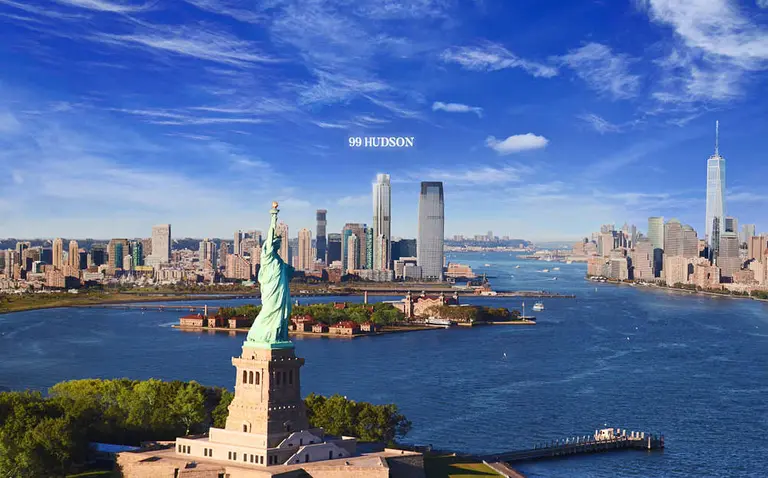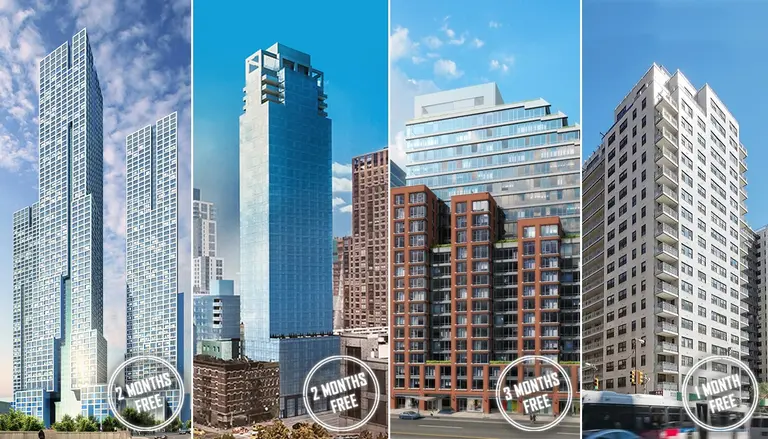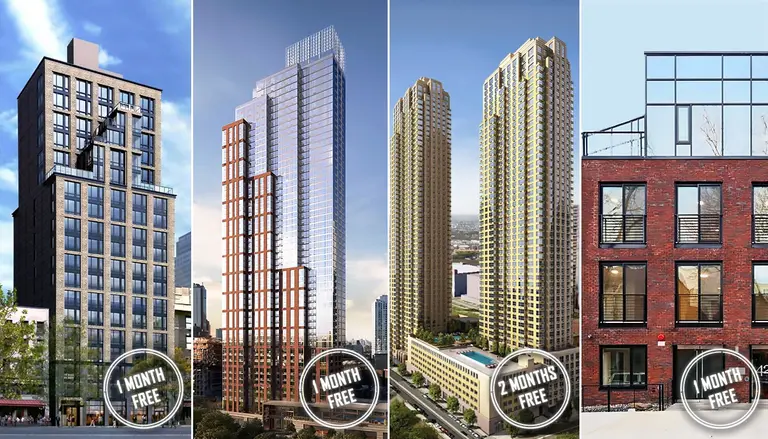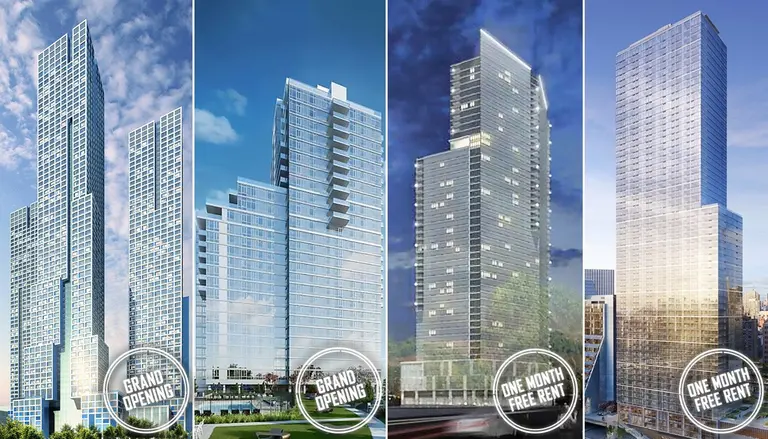Skyline Wars: New Jersey’s Waterfront Transforms With a Tall Tower Boom
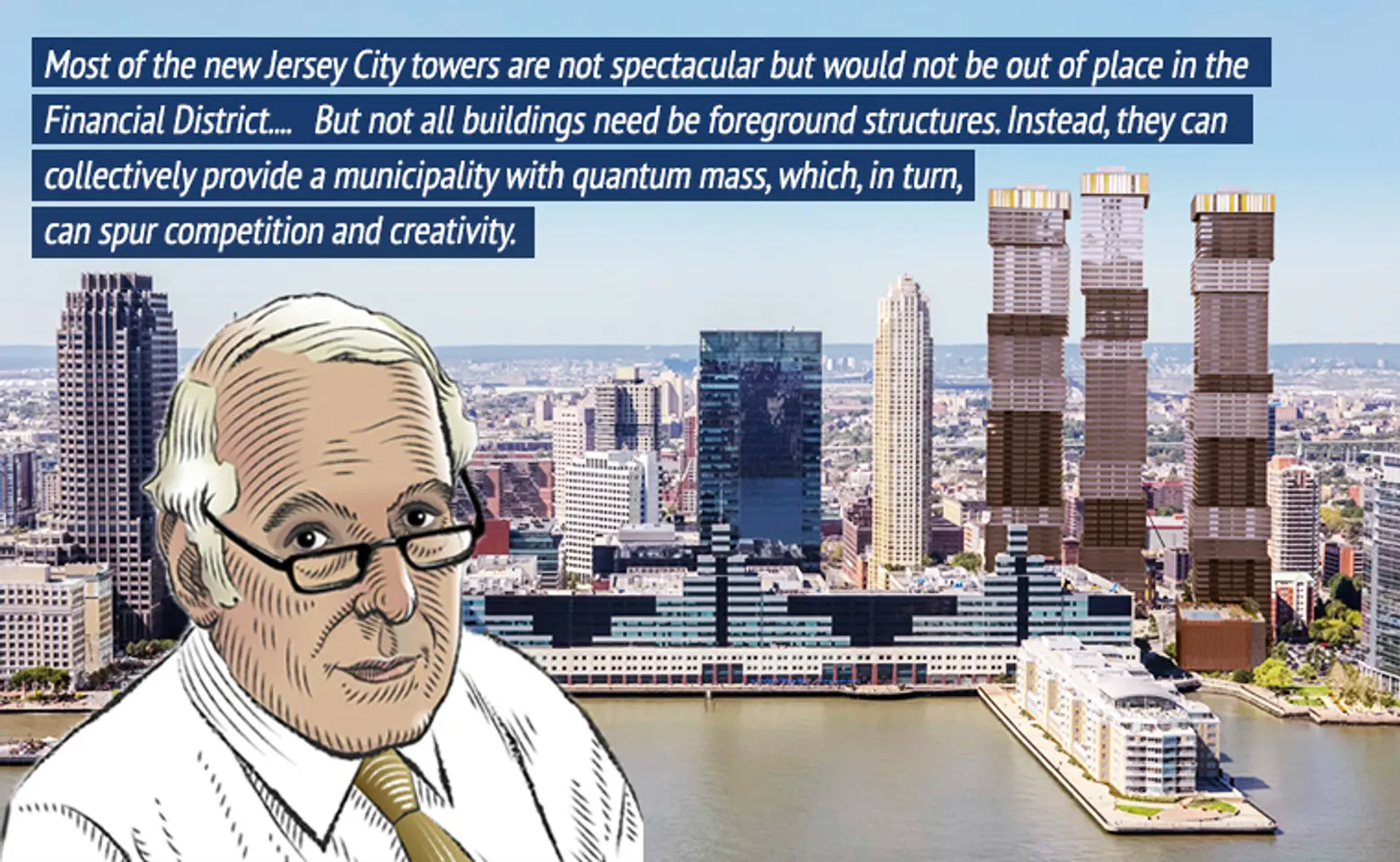
Carter Uncut brings New York City’s latest development news under the critical eye of resident architecture critic Carter B. Horsley. Here, Carter brings us his seventh installment of “Skyline Wars,” a series that examines the explosive and unprecedented supertall phenomenon that is transforming the city’s silhouette. In this post Carter looks at the new New Jersey skyline.
The hulking, 781-foot-high Goldman Sachs tower at 30 Hudson Street in Jersey City is like the Rock of Gilbraltar to Lower Manhattan’s famed skyline: massive and impressive. To some, perhaps, it conjures a Monty Python catapult or a very steep cliff on which to mount the Guns of Navarone for an assault on Lower Manhattan. It dominates the Jersey City skyline, which is a bit Spartan, especially in comparison with Brooklyn’s. Most of the skyscrapers in Brooklyn, however, are not directly on the waterfront and the Goldman tower is very much “in your face” on the water. Furthermore, all of a relative sudden, Jersey City is about to explode with three taller towers, which I can only describe as delirious, dancing, shimmy-shimmy-shake buildings with drop-dead vistas of Manhattan and the Hudson.
 New York Harbor from near the Statue of Liberty looking north
New York Harbor from near the Statue of Liberty looking north
Designed by Cesar Pelli & Associates, the 42-story, 1.4-million-square-foot Goldman tower was erected to house the Manhattan-based company’s traders who were scattered about in several Lower Manhattan locations. The tower was completed in 2004 when its neighborhood was rather derelict and mostly an industrial part of Jersey City. The employees, however, balked at the move across the river and in 2010 Goldman Sachs opened a new headquarters at the World Financial Center, which is now known as Brookfield Place in Battery Park City. Part of the Goldman construction is now leased to other tenants.
Times have changed dramatically in Jersey City, however, and now the mammoth Goldman Sachs promontory is fronting a growing range of towers, including some nearby that may surpass it in height.
 The Jersey City skyline on the Hudson River is growing. The first of three towers at the URL Harborside Complex is shown at left center with crane on top.
The Jersey City skyline on the Hudson River is growing. The first of three towers at the URL Harborside Complex is shown at left center with crane on top.
Goldman Sachs anchors the southern end of the Jersey City waterfront and the Lefrak Organization’s mammoth redevelopment of rail yards into a mixed-use complex known as Newport anchors the north end. In the middle, a very long low-rise commercial complex known as Harborside with three slim and short towers handsomely lounged.
Now such serenity is being joggled with the construction of a three-tower complex being developed by Mack-Cali, one of the largest developers in New Jersey, and Ironstate Development. It is known as the Urban Ready Living Harborside complex in Jersey City.
If the Goldman Sachs tower is the hippopotamus in the front yard, the URL Harborside complex is a cluster of gangly but attractive giraffes twisting about for goodies.
The URL Harborside Complex ↑
The URL development is a complex of three similar Jenga-like towers with shifted floor plates and slightly different heights. The first tower was recently topped out and the complex is just behind the riverfront’s Harborside low-rise commercial complex.
The URL towers stylistically broadly resemble the design of the 821-foot-high 56 Leonard Street in Lower Manhattan, designed by Herzog & de Meuron. That very tall, single tower is notable for resting on a silvery “egg” sculpture design by Anish Kapoor and having many of its lower and upper floors rakishly shift their position, giving its silhouette a markedly haphazard appearance that also earned it considerable praise as the most exciting new project in New York in recent years. Construction on the tower, however, started in 2007 but was delayed because of the economic recession and is still in construction in 2016.
The URL Harborside project, designed by Concrete and HLW International, experienced no such growing pains. Its construction started in 2014 and its first tower topped out at the end of 2015 at 700 feet.
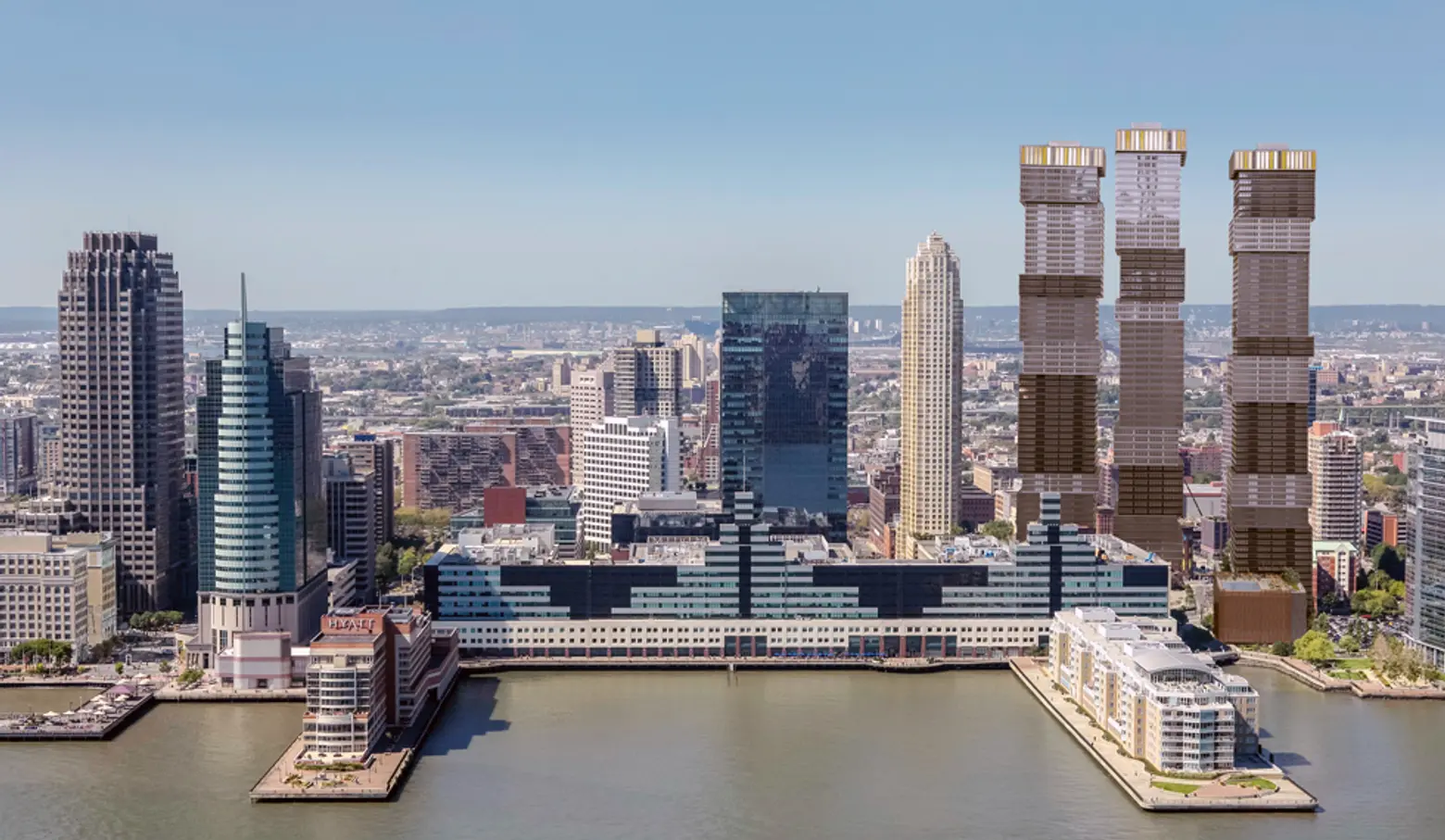 Rendering of the URL Harborside tower complex shows original low-rise megastructure complex of riverfront Harborside complex
Rendering of the URL Harborside tower complex shows original low-rise megastructure complex of riverfront Harborside complex
When completed, the three-tower complex will become the region’s jazziest and introduce the visual dynamics of movement into the normally static world of urban architecture. The eagerly awaited 56 Leonard may be more dashing and complex but it will not be as visible as the Jersey trio.
99 Hudson Street ↑
Recently, China Overseas America announced it would build a 95-story apartment tower at 99 Hudson Street near the waterfront a few blocks south of Harborside. It will be 990-feet high and contain 760 apartments. The tallest building planned for Jersey City, it will have no setbacks and a hexagonal plan.
In September, it was reported that another 95-story tower was being planned for 55 Hudson Street. Jersey City’s Mayor Steven Fulop relayed that “Goldman Sachs came in regarding a new tower next to the existing building on the waterfront, and we’re just starting to talk about that.”
100 Caven Point Road ↑
Early this year, New Jersey lawmakers reached a deal to put a state-wide referendum on the ballot in November asking voters whether to approve two new casinos in the northern part of the state. The deal would impose a minimum of $1 billion in investment in each of the two new casinos and give existing casino operators in Atlantic City six months to propose projects in northern New Jersey, adding that if they fail to do so both new licenses would be available to any interested party. Paul Fireman, the founder of Reebok, has proposed a 95-story tower and casino at 100 Caven Point Road at the south end of Jersey City.
Ellipse Riverfront Tower ↑
Last December, the Lefrak Organization broke ground on a 43-story, waterfront apartment tower that will be known as the Ellipse. It is a very handsome tower that has been designed by Arquitectonica and it will sit beside LeFrak’s 600-acre Newport complex. The 444-foot-high tower will contain 376 rental apartments and will rise on property east of 14th Street, not far from the pedestrian bridge that connects the Hoboken waterfront to the Jersey City waterfront.
Journal Squared ↑
The Kushner Real Estate Group and National Real Estate Advisors are moving ahead with a three-tower complex known as Journal Squared at Summit and Pavonia avenues. The center tower will be 742 feet high and 70 stories. The other towers will be 635 and 562 feet high.
Jared Kushner is also planning a 700-foot-tall apartment tower at 1 Journal Square. He is also erecting a 650-foot-high tower at 30 Journal Square that will incorporate the former headquarters building of the Jersey Journal.
70-90 Columbus Avenue ↑
Construction is advancing on 70-90 Christopher Columbus Avenue, the first of two towers being developed by Ironstate Development Company and Panepinto Properties. 70 and 90 Columbus Street will be two 50-story buildings. 70 Columbus will have 150 hotel rooms and 550 rental units above a retail base and is now complete. 90 Columbus will be entirely residential and construction is still underway.
The Hudson Greene Complex ↑
The Hudson Green complex, developed by Equity Residential and designed by CetraRuddy at 70 and 77 Greene Street in 2010, is one of the most handsome in Jersey City thanks to its blue glass facades, gentle angles and balcony projections on its lower sections. Hudson Greene West at 70 Greene Street has 480 apartments. Hudson Greene West at 77 Greene Street has 420 apartments.
10 Exchange Place and 101 Hudson Street ↑
One of the handsomest towers in Jersey City is 10 Exchange Place (seen above left), a 490-foot-high office building that was completed in 1989. A block further inland is the brown-brick 101 Hudson Street (seen above right) with its handsome, Art Deco-style massing of setbacks.
Trump Plaza and 65 Bay Street ↑
Trump Plaza (seen above right), was completed in 2008 by Trump International Realty as a condo tower. It is at 88 Morgan Street in Jersey City and is 532 feet high. A similar tower, this one a rental, that is 535 feet tall is under construction at 65 Bay Street (seen above left) and is being developed by Kushner Companies.
***
Top, freight rail era waterfront, circa 1930s (source: Jersey City Public Library) looking across the Hudson to Lower Manhattan with a few skyscraper spikes. Bottom, same recent view as top with rail yards redeveloped by the LeFrak Organization (source: Newport Development Associates).
In “Jersey City on the Rise,” a research paper of the Council on Tall Buildings and Urban Habitat published last year, Robert Cotter and Jeff Wenger, the planning director and principal planner of Jersey City, respectively, wrote the following:
- “During the 19th Century and into the 20th, the railroads occupied almost the entire five mile shorelines and extended Jersey City with landfill into the Hudson River. This created over 400 acres of rail yard in downtown Jersey City’s Hudson River waterfront, as well as massive multistoried warehouse facilities to service the port. Bypassing the Erie Canal and the New York side of the port, cargo from the heartland of the United States was brought by rail to Jersey City waterfront for overseas shipping.
- “All this thrived and grew until the invention of standardized shipping containers in the 1950s and the shift to intermodal freight transport. Overnight, the shipping industry changed from break bulk method to containerized method. A system that had been in use for millennia was suddenly obsolete, as a new period of globalization began with the container. And so in 1956, the decline of the Jersey City waterfront began. Containerization required a complete reorganization and redesign of port facilities with large tracts of land to stack and sort containers, as well as far fewer but much larger shipping berths to accommodate ever large container ships. Both sides of the Hudson River are obsolete for this operation and the port activities relocated yet again further west to port Newark and Port Elizabeth.
- “The collapse of Jersey City’s rail and shipping economy occurred over the next decade….Seeking a way to revive the city, Mayor Thomas Gangemi called upon the state of New Jersey’s Office of Planning for help in 1962. The plan that emerged was to create ‘Wall Street West.’ Situated one mile west and a five minute subway ride from New York’s financial district, the city was primed for rebirth as a financial center. While it would take almost 40 years to build the 800 foot tall Goldman-Sachs building, within ten years of the Wall Street West plan, the first new office buildings in 50 years were built on Montgomery Street, and they became the focus of the Over the Counter stock market trading….
- “Since 1980, 18 million square feet of office space have been developed on the Jersey City waterfront, generating the highest price per square foot office deals in New Jersey history and marking the success of the original ‘Wall Street West’ concept. Currently over 6,000 housing units are under construction with another 20,000 units approved by the planning Board. Much of this development is accommodated with high rise construction with approximately 28 buildings over 300 feet tall and 6 buildings over 500 feet with several more under construction. China Overseas has approvals for a new tower of 889 feet. Within a few years, Jersey City will overtake Newark as New Jersey’s most populous city….”
Apart from the sleek but bulbous Goldman Sachs shaft and the jaunty trio of the URL Harborside trio, most of the new Jersey City towers are not spectacular but would not be out of place in the Financial District and Upper East Side of Manhattan.
But not all buildings need be foreground structures. Instead, they can collectively provide a municipality with quantum mass, which, in turn, can spur competition and creativity. After all, for many cities, the dervish peaks of the URL Harborside can be hearty substitutes for an Eiffel Tower.
+++
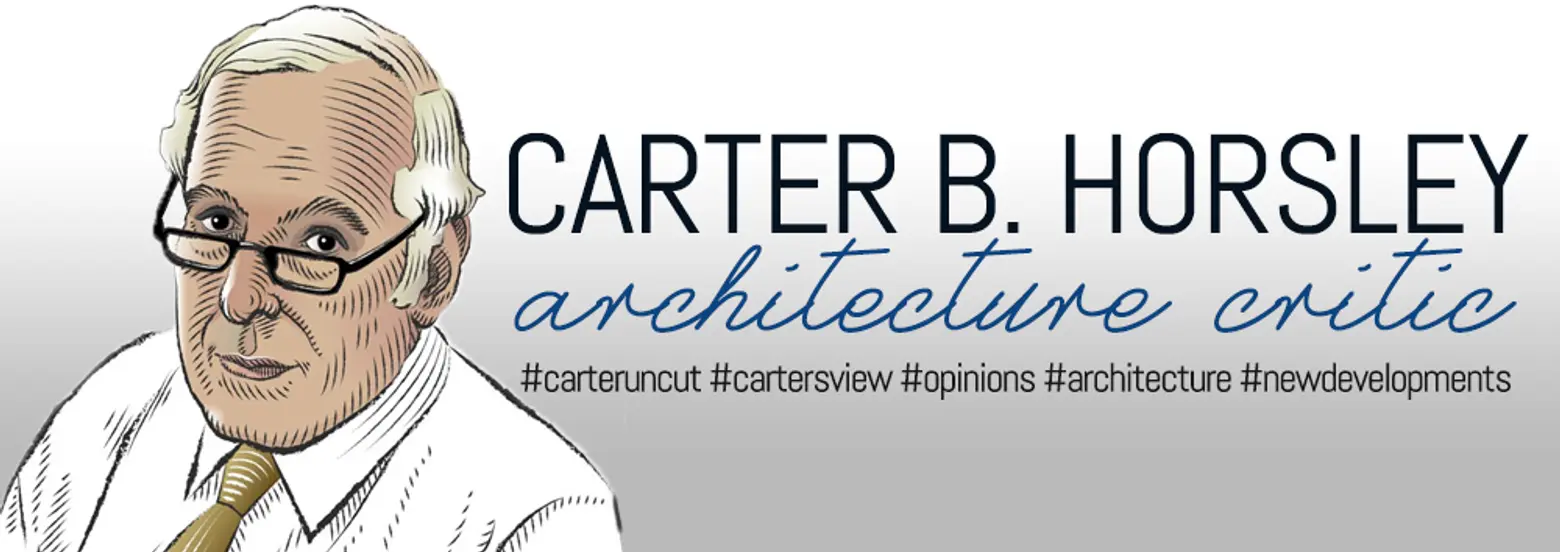
Carter is an architecture critic, editorial director of CityRealty.com and the publisher of The City Review. He worked for 26 years at The New York Times where he covered real estate for 14 years, and for seven years, produced the nationally syndicated weeknight radio program “Tomorrow’s Front Page of The New York Times.” For nearly a decade, Carter also wrote the entire North American Architecture and Real Estate Annual Supplement for The International Herald Tribune. Shortly after his time at the Tribune, he joined The New York Post as its architecture critic and real estate editor. He has also contributed to The New York Sun’s architecture column.
